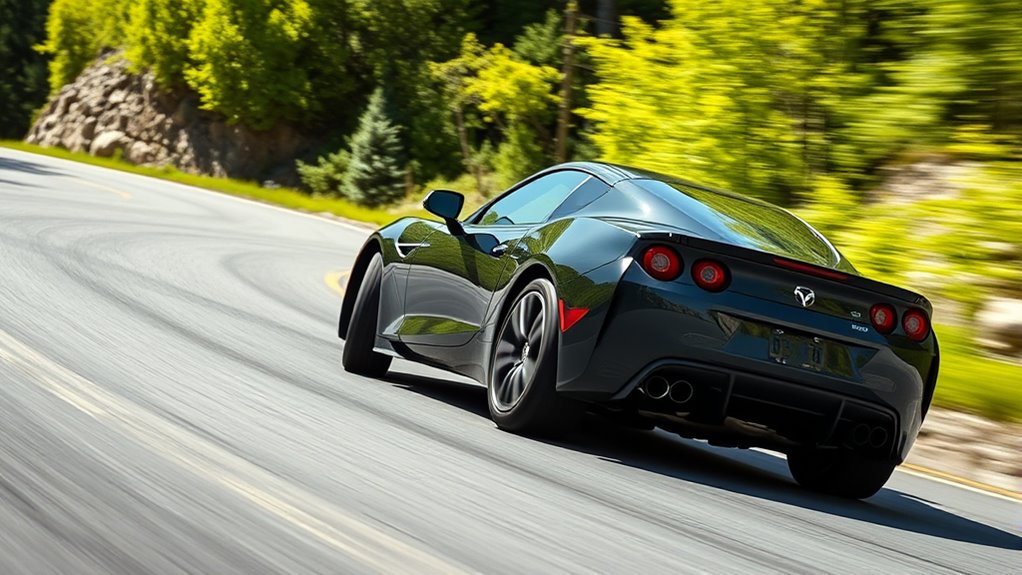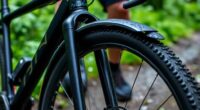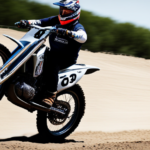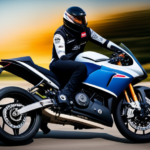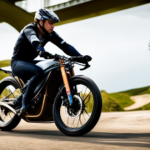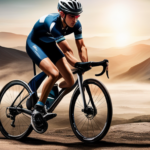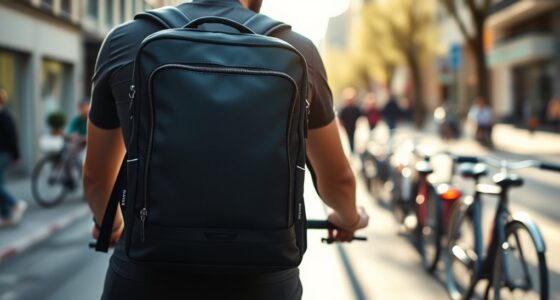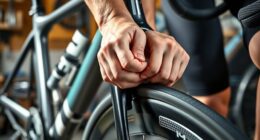To improve your cornering on a budget, start by regularly checking and adjusting your tire pressure for the best grip—lower it slightly on wet surfaces and raise it for dry conditions. Practice smooth, deliberate steering and stay relaxed through turns, shifting your weight properly. Consider minor bike setup tweaks like handlebar angles or suspension if possible. These simple, cost-effective tips can boost your confidence and control, and if you keep exploring, you’ll discover even more ways to refine your technique.
Key Takeaways
- Regularly check and adjust tire pressure for optimal grip based on surface conditions.
- Practice smooth, deliberate steering inputs to enhance control during turns.
- Maintain a relaxed riding posture and shift weight into corners for better balance.
- Use inexpensive tools like a pump to fine-tune tire pressure before rides.
- Make small, incremental bike setup adjustments, such as handlebar angles, to improve responsiveness.
Affordable Tips to Enhance Cornering Skills
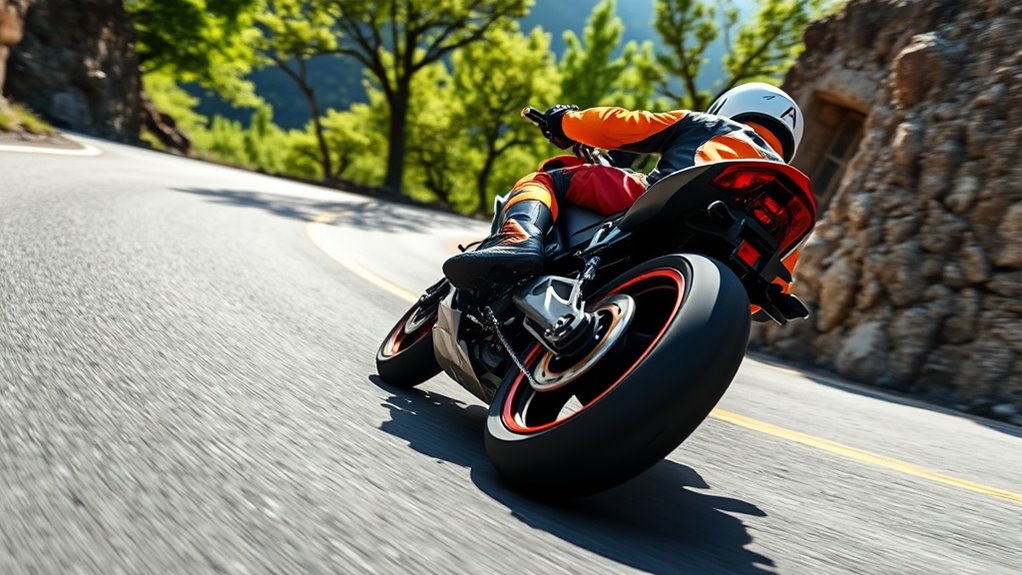
Ever wonder how you can sharpen your cornering skills without breaking the bank? The good news is, you don’t need expensive gear or professional coaching to make noticeable improvements. Small, cost-effective tweaks to your bike’s setup and riding habits can substantially enhance your cornering. Two key areas to focus on are tire pressure and steering adjustments. These simple steps can boost your confidence and control on turns, all while keeping your budget intact.
First, pay attention to your tire pressure. Properly inflated tires are fundamental for good cornering. Under-inflated tires can cause your bike to feel sluggish, reduce grip, and make steering less responsive. Over-inflated tires, on the other hand, might give you a harsher ride and less contact patch with the road, decreasing traction. Check your tire pressure regularly, ideally before every ride, and keep it within the manufacturer’s recommended range. Adjusting your tire pressure to suit riding conditions—slightly lower for wet or loose surfaces, and a bit higher for dry, smooth roads—can improve grip and stability. These adjustments are free if you already have a pump, and they require only a few minutes to execute, but the gains in control can be substantial.
Check and adjust your tire pressure regularly for better grip and responsiveness during cornering.
Next, focus on steering adjustments. Your steering technique plays an essential role in how confidently you navigate turns. Practice gentle, deliberate steering inputs rather than abrupt movements. When approaching a corner, look through the turn to where you want to go, and let your eyes guide your hands and body. This helps you make smoother steering corrections. You can also experiment with your handlebar pressure—less force generally results in more precise control. If your bike has adjustable steering components, such as a riser or different handlebar angles, consider tweaking them to suit your riding style. Even minor adjustments can make a noticeable difference in how responsive your bike feels during cornering. Remember, small, incremental changes are best; oversteering or aggressive inputs can cause you to lose traction or upset your balance. Additionally, maintaining optimal tire contact with the road surface through proper suspension setup can further enhance cornering performance, as suspension tuning directly impacts grip and stability.
Finally, combine these tips with good riding posture—stay relaxed, shift your weight appropriately, and lean into corners instead of braking mid-turn. These habits, coupled with tire pressure management and steering adjustments, create a solid foundation for better cornering. The best part is, these methods don’t require a big investment. You can implement them immediately, and over time, you’ll develop a more intuitive, confident riding style. Improving your cornering doesn’t have to cost a fortune—it’s about making smarter choices with what you already have and dedicating a little time to practice.
Frequently Asked Questions
What Are Common Mistakes Beginners Make When Cornering?
Beginners often make mistakes like improper body positioning, which can throw off balance during a turn. You might also neglect steering correction, causing the bike to drift too wide or too tight. To improve, focus on leaning your body correctly and making smooth, controlled steering corrections. Avoid sudden movements and keep your eyes on the exit of the corner. With practice, these habits become second nature, making your turns safer and more confident.
How Do Weather Conditions Affect Cornering Safety?
Weather conditions considerably impact your cornering safety by altering road conditions. Rain makes surfaces slippery, reducing traction and increasing the risk of skidding. Snow and ice create hazardous, unpredictable surfaces, requiring you to slow down and be extra cautious. Even fog can impair visibility, making it harder to judge corners accurately. Always adapt your speed and riding style to the weather impact to stay safe and maintain control while cornering.
Can Bike Maintenance Improve Cornering Performance?
Yes, bike maintenance can greatly improve your cornering performance. Regular bike tune-ups guarantee your bike runs smoothly, while maintaining proper tire pressure enhances grip and stability. When your tires are properly inflated, you’ll have better control during turns, reducing the risk of slipping. Keep your bike in top shape, check your tire pressure frequently, and schedule tune-ups to optimize your cornering ability without breaking the bank.
What Safety Gear Is Essential for Aggressive Cornering?
You need essential safety gear for aggressive cornering—think tight helmet fit that keeps it secure and gloves with a strong grip to maintain control. Without these, your ride becomes risky, and the thrill turns dangerous. Always double-check your helmet fits snugly, and your gloves grip firmly, especially when pushing limits. With this gear, you stay safe, confident, and ready to conquer every sharp turn that comes your way.
How to Handle Unexpected Obstacles During a Turn?
When you encounter unexpected obstacles during a turn, stay calm and focus on obstacle avoidance. Slow down if needed, and use emergency maneuvering techniques like quick steering adjustments to steer around the obstacle safely. Keep your eyes on the path ahead and anticipate potential hazards. Practicing these skills will help you respond swiftly and confidently, minimizing risks without needing expensive equipment or modifications.
Conclusion
By applying these budget-friendly tips, you’ll start to feel the thrill of leaning into every turn, the wind rushing past as your confidence grows. Imagine carving through corners with smooth precision, your bike responding effortlessly beneath you. With each ride, your skills sharpen, transforming every twist and turn into a moment of pure freedom. Keep practicing, stay patient, and soon you’ll be conquering corners like a seasoned pro—without breaking the bank.
